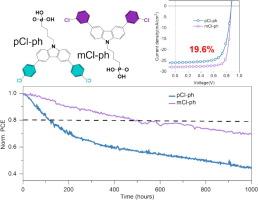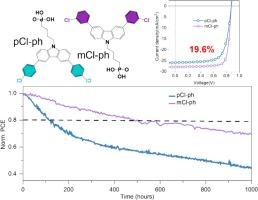通过氯异构化自组装分子明智地抑制界面非辐射重组,实现高效耐用的有机太阳能电池
IF 13.2
1区 工程技术
Q1 ENGINEERING, CHEMICAL
引用次数: 0
摘要
在有机太阳能电池(OSCs)中,电荷输运能力不足以及自组装分子(sam)的能级排列不当导致了严重的界面非辐射重组,严重影响了相应器件的性能和鲁棒性。本文提出了一种分子异构化策略,将氯原子接枝在苯侧链取代咔唑末端基的对位(pCl-ph)或间位(mCl-ph)上,以构建高效可靠的OSC器件。与准定位相比,我们发现元cl变电所可以激发分子间相互作用,进一步促进分子堆积,有利于增强载流子电导率和改善陷阱密度。此外,mCl-ph的最佳功函数可调性触发了有利的能级布局,而pCl-ph的过深能级布局则诱导了周向电荷积累,并进一步催化了难以忍受的非辐射复合损失。因此,冠军功率转换效率(PCE)从16.1% (pCl-ph)提升到19.6% (mCl-ph),在不同混合体系中具有优越的通用性。更引人注目的是,在mCl-ph装置(pCl-ph装置T80:111 h)中获得了提高的操作稳定性(T80:575 h),表明SAM异构化是一种具有高效率和稳定性的OSCs方法。本文章由计算机程序翻译,如有差异,请以英文原文为准。


Judicious inhibition of interfacial non-radiative recombination via chlorine-isomerized self-assembled molecules for efficient and durable organic solar cells
Moderate charge transporting capacity together with inexpedient energetic level alignment of the self-assembled molecules (SAMs) initiate severely interfacial non-radiative recombination in organic solar cells (OSCs), which significantly hinder the performance and robustness of corresponding devices. Herein, a molecular isomerization strategy is developed to construct promising SAM for efficient and reliable OSC devices, where chlorine atoms are grafted on either para- (pCl-ph) or meta- (mCl-ph) location in benzene sidechain substituted carbazole terminal group. In comparison with para location, we found the meta-Cl substation can instigate the intermolecular interaction and further boost molecular packing, which is beneficial to strengthen the carrier conductivity and ameliorate the trap density. Furthermore, the optimal work function tunability of mCl-ph trigger the favorable energy-level layout, whereas over deep-lying level arrangement of pCl-ph induced the circumferential charge accumulation and further catalyze the insufferable non-radiative recombination loss. Consequently, the champion power conversion efficiency (PCE) is upgraded from 16.1 % (pCl-ph) to 19.6 % (mCl-ph) with superior generality in diverse blend system. More strikingly, the raised operation stability (T80:575 h) is harvested in mCl-ph devices (pCl-ph devices T80:111 h), demonstrating that SAM isomerization is an appealing approach for OSCs with high efficiency and stability simultaneously.
求助全文
通过发布文献求助,成功后即可免费获取论文全文。
去求助
来源期刊

Chemical Engineering Journal
工程技术-工程:化工
CiteScore
21.70
自引率
9.30%
发文量
6781
审稿时长
2.4 months
期刊介绍:
The Chemical Engineering Journal is an international research journal that invites contributions of original and novel fundamental research. It aims to provide an international platform for presenting original fundamental research, interpretative reviews, and discussions on new developments in chemical engineering. The journal welcomes papers that describe novel theory and its practical application, as well as those that demonstrate the transfer of techniques from other disciplines. It also welcomes reports on carefully conducted experimental work that is soundly interpreted. The main focus of the journal is on original and rigorous research results that have broad significance. The Catalysis section within the Chemical Engineering Journal focuses specifically on Experimental and Theoretical studies in the fields of heterogeneous catalysis, molecular catalysis, and biocatalysis. These studies have industrial impact on various sectors such as chemicals, energy, materials, foods, healthcare, and environmental protection.
 求助内容:
求助内容: 应助结果提醒方式:
应助结果提醒方式:


